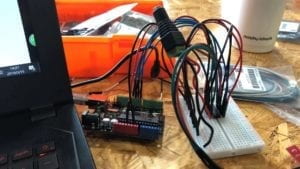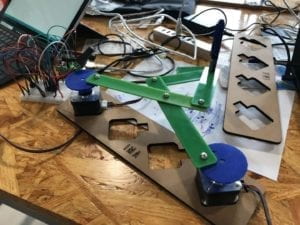On recitation on 3.15, we did an exercise of building a drawing machine. We used Arduino as always, as well as a servo, an H-bridge, which is a new component of the circuit. Here is the circuit
Below is the code we used to drive the servo
#include <Stepper.h>
const int stepsPerRevolution = 200; // change this to fit the number of steps per revolution
// for your motor
// initialize the stepper library on pins 8 through 11:
Stepper myStepper(stepsPerRevolution, 8, 9, 10, 11);
void setup() {
// set the speed at 60 rpm:
myStepper.setSpeed(60);
// initialize the serial port:
Serial.begin(9600);
}
void loop() {
// step one revolution in one direction:
Serial.println(“clockwise”);
myStepper.step(stepsPerRevolution);
delay(500);
// step one revolution in the other direction:
Serial.println(“counterclockwise”);
myStepper.step(-stepsPerRevolution);
delay(500);
}
After setting up circuit and the code, we began to make the arm to control the pen to move and draw patterns.
Here’s the video of how our project worked. Very excited!
Question 1: After using several types of sensors, actuators, and exploring with processing combined with electronic device, I began to realize the infinite possiblities of physical computing, and there are even more to discover if interactive concepts are attached. Thus, I’m most interested in building interactive type of machines, with visual illustrations and practical functions, such as VR lens. Those device can provide us more sense of our surroundings and is enable users to receive more informations from current situation, which is a cool idea to me.
Question 2: The “wooden mirror” seems really appealing to me. The artist used an electromechanically “mirror” which consists with controllable pieces of single conponents, such as wood pieces and other materials to build pixels that form a bigger picture. The camera installed can track the target that faces the mirror and then reacts by sending signals to those “pixels” and reflects the target on the mirror. This seems to me is an authentic interactive art project. By sensing the image of the user and tracking motions, there are communications in between. Compared to our project this time, the difference is quite obvious, the interacting part of the art piece is much more natural and visualized, what’s more,the device acts with flexibility.Those together with the use of warm style materials like woods, give a sense of romance to the art piece.
The artist was wise on choosing the specific actuators for the art works, since the movements of those mechanical “pixel” are complicated. To choose appropriate actuators, enough observation and experience are important. To make sure what is the goal and thus to think and choose based on that.

